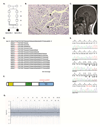NGLY1 mutation causes neuromotor impairment, intellectual disability, and neuropathy
- PMID: 25220016
- PMCID: PMC4804755
- DOI: 10.1016/j.ejmg.2014.08.008
NGLY1 mutation causes neuromotor impairment, intellectual disability, and neuropathy
Abstract
N-glycanase 1 (NGLY1) is a conserved enzyme that is responsible for the deglycosylation of misfolded N-glycosylated proteins in the cytoplasm prior to their proteasome-mediated degradation. Disruption of this degradation process has been associated with various neurologic diseases including amyotrophic lateral sclerosis and Parkinson's disease. Here, we describe two siblings with neuromotor impairment, apparent intellectual disability, corneal opacities, and neuropathy who were found to possess a novel homozygous frame-shift mutation due to a 4 base pair deletion in NGLY1 (c.1533_1536delTCAA, p.Asn511LysfsX51). We hypothesize that this mutation likely limits the capability of neuronal cells to respond to stress due to accumulation of misfolded proteins, thereby impairing their survival and resulting in progressive loss of neurological function.
Keywords: Deglycosylation; Intellectual disability; NGLY1; Neuromotor defect; Whole-exome sequencing.
Copyright © 2014 Elsevier Masson SAS. All rights reserved.
Conflict of interest statement
We report no conflict of interest.
Figures

References
-
- Auer-Grumbach M, Mauko B, Auer-Grumbach P, Pieber TR. Molecular genetics of hereditary sensory neuropathies. Neuromol Med. 2006;8:147–158. - PubMed
-
- Dyck P. Neuronal atrophy and degeneration predominantly affecting peripheral sensory and autonomic neurons. In: Dyck P, Thomas PK, Griffin JW, Low PA, editors. Peripheral neuropathy. Philadelphia: WB Saunders; 1993. pp. 1065–1093.
Publication types
MeSH terms
Substances
Grants and funding
LinkOut - more resources
Full Text Sources
Other Literature Sources
Medical
Molecular Biology Databases

